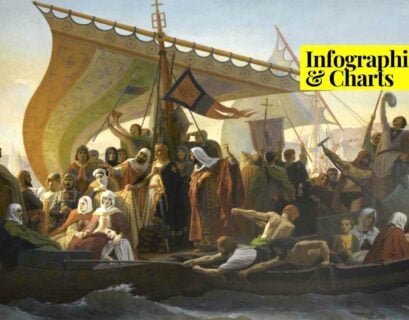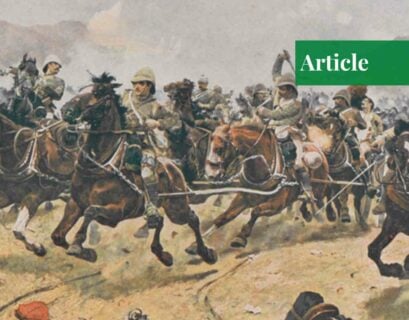Introduction
Europe has always been an epicenter of disagreements, conflicts, violence, disputes, and power struggles. It’s no wonder that war is probably inevitable in such a large and inextricably linked continent, with rapidly shifting borders through most of history. Austria and Prussia were two such states that competed for dominance and power consolidation in Central Europe.
Prussia was transforming into the most dominant and influential among all the integrated states, second only to the Austrian Empire. It was led by the Hohenzollern family, majorly King William I, and Prime Minister Otto von Bismarck. On the other hand, Emperor Franz Joseph I who belonged to the dynasty of Habsburg ruled over Austria.
Even though these rulers were competing to gain more power and dominance in the region, particularly to expand their sphere of influence and authority over Central Europe, they also cooperated during the period of the Second Schleswig War, with both the Austrian and Prussian Empires conquering the area of Schleswig Holstein jointly which was controlled by Danish.
Seven Weeks War of 1866
In 1866, Prussia strongly disagreed with the governmental decisions and political choices made by the Governor of Austria. It triggered several conflicts and disputes between both states and resulted in the maneuvering of troops by Austria along the border side of Prussia.
Both Austria and Prussia started to plan strategies for the Austro-Prussian War of 1866 against each other. Otto von Bismarck suggested approaching the southern ally, Italy, which affirmed on April 8 that if Prussia were to launch a war against Austria within the upcoming ninety days, it would join hands with the German state in an attempt to counter and confront Austria’s strength.
Austria, however, was cognizant of the newly gained companionship and started deploying its troops all along the Italian border. Approximately five days later, Italy asserted general maneuvering, and Austria followed suit the next day. Consequently, Prussia started its maneuvering in various stages starting from May 3 to May 12.
All the parties started to prepare for war, and many of the German states formed alliances with the state of Austria. Consequently, Prussia conquered Saxony, Hanover, as well as Hesse on the 15th of June in retaliation with the purpose of defeating its neighbors before they would stand behind Austria. A few days later, Italy fulfilled its promise by declaring war against Austria.

Austro-Prussian Major Battles
At the Battle of Langnsalza on June 27, Prussia experienced its first defeat against Hanover, but the latter’s success was brief because the remaining troops of Prussia ultimately besieged them and pushed them to surrender. However, the Austrian commander was not confident to indulge his own forces in a direct war. Even when outweighing the Prussians, the Austrians were surrounded and forced back as their adversaries fought with clever antagonism.
By July, Austrian general, Ludwig August Ritter von Benedek, had abandoned his hopes and instructed the withdrawal of his forces. He wrote to Emperor Franz Josef, pleading with him to improve relations with the Prussians in order to prevent a “catastrophe for the Austrian army”.
The Prussian army was fully prepared to initiate an attack against Austria at the start of July at the Battle of Koniggratz. The Austrians approximately had a force of 215,000, but the Prussians only had about 124,000. The Prussian army headed by Karl Eberhard Herwarth von Bittenfeld was attacked by the Austrian army. This offensive attack made Bittenfeld reluctant to launch a full attack as it seemed unwise therefore he ordered Alexander von Schoeler to take a defensive position along with the advanced guard’s 7th battalion.
In the meantime, General Eduard von Fransecky of Prussia advanced and confronted two Austrian corps. King William I, seeing this success, gave an order to the army to unite with General Fransecky’s forces who were advancing towards Sadová which they captured soon.
The Prussian Won Battle of Königgrätz
The Prussian fourth and eighth divisions wanted to surpass the River of Bystrice and join their companions, but they were confronted with intense Austrian bombardments. Benedek, on the other hand, chose not to proceed with a counter-offensive at the same time, enabling the Prussians to preserve some degree of resistance for maintaining their strength.
Despite Prussians having been momentarily pushed back by the Austrians, the Austrians made a mistake when Benedek denied initiating a full-scale attack against Prussian battalions. The Prussians retaliated strongly by defeating Austria’s army, resulting in a victory for the Prussians.
The Battle of Königgrätz was a decisive victory for Prussia, and it had a significant impact on the course of European history. It led to the unification of Germany under Prussian leadership and to the decline of Austria’s power in Europe. The battle also had a number of important military lessons. It showed the importance of superior training and tactics, as well as the use of new weapons and technology. The Prussian army was equipped with the latest weapons and technology, including the Dreyse needle gun, which was a breech-loading rifle that was much more accurate and powerful than the muzzle-loading rifles used by the Austrians.
Minor conflicts persisted till July 22nd, when a peace accord was finally accepted at 7:36 p.m. The peace agreement that ended the war, the Peace of Prague, was signed on August 23, 1866. At the suggestion of Bismarck, no further territory had been taken under the sphere of influence of Prussia. Under the terms of the peace treaty, Austria was forced to cede Venetia to Italy and to give up its leadership of the German Confederation. The war also led to the creation of the North German Confederation, which was dominated by Prussia.

However, some parts of Austria including Hesse, Schleswig Holstein, and Hanover were taken, and German states (with the exception of Austria) were unified under the authority of Emperor William I. Furthermore, the Treaty of Vienna was signed in 1866 after the Third Battle of Italian Liberation, which occurred throughout the Austro-Prussian War after Italy came to the defense of Prussia.
If you want to submit your articles and/or research papers, please check the Submissions page.
The views and opinions expressed in this article/paper are the author’s own and do not necessarily reflect the editorial position of Paradigm Shift.



















